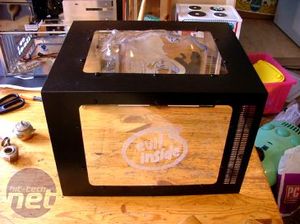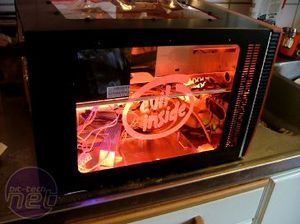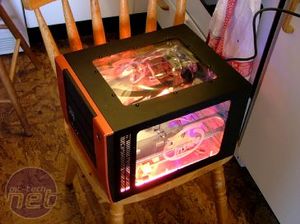

Pure evil
Theme: Demonic SFF case based on Intel Inside logo
Materials: Aspire AS-X-Qpack mATX
Build Time: 24 hours
People often say "start off small and work your way up" so I did - let's kick things off with an Aspire AS-X-Qpack SFF case. The theme for this case is the familiar "Evil Inside" case badge logo parody of Intel Inside - that will be the main engraving.


This case is different from a lot of SFF cases in that it comes factory fitted with plexi windows on both side and the top panel. This makes it perfect for some experimental plexi-forming. Let's get started...
The plastic they use for these windows (probably sheet Polystyrene) is a Thermoplastic which means it can be heated (or indeed melted!) and remolded easily. The opposite would be a Thermosetting plastic which is essentially "single use" - these cannot be remolded into funky new shapes. Luckily, we're using the former.


Plexi-forming involves heating up the perspex until it becomes flexible, and then molding it into the desired shape. The temperatures involved are fairly high - too hot to just mush it with your hands, so I borrowed a nose piercing from a giant and started warming the window.
Through the magic of Worklogs, you don't get to see the four previous windows that I cracked - we just get to fast-forward to the end result. Because it is a shape formed from a transparent material, it was quite difficult to photograph but you can see here that it is a head - a devil's head with little horns. Very evil. You can find the full step-by-step guide in the Project Worklogs forum.


The side windows will have the 'evil inside' logo on them. It is a pretty simple logo, so I printed it, taped it to the window and engraved it. Repeat for the other side.


The case is not going to have a system installed in it for display, so I needed a way to power some cold cathodes to provide light. The answer was a PSU tester, also made by Aspire. This means I don't have to hotwire the PSU to provide power, since all power supplies normally need to plugged into a motherboard before they will switch on. The lighting is provided from a pair of 30cm red, CoolerMaster CCFLs.
Here is the final product:




As I have said, it is very difficult to photograph - you really need to see it in person to appreciate the full effect. It will, of course, be on display at Dreamhack along with the other cases in this article.

MSI MPG Velox 100R Chassis Review
October 14 2021 | 15:04







Want to comment? Please log in.